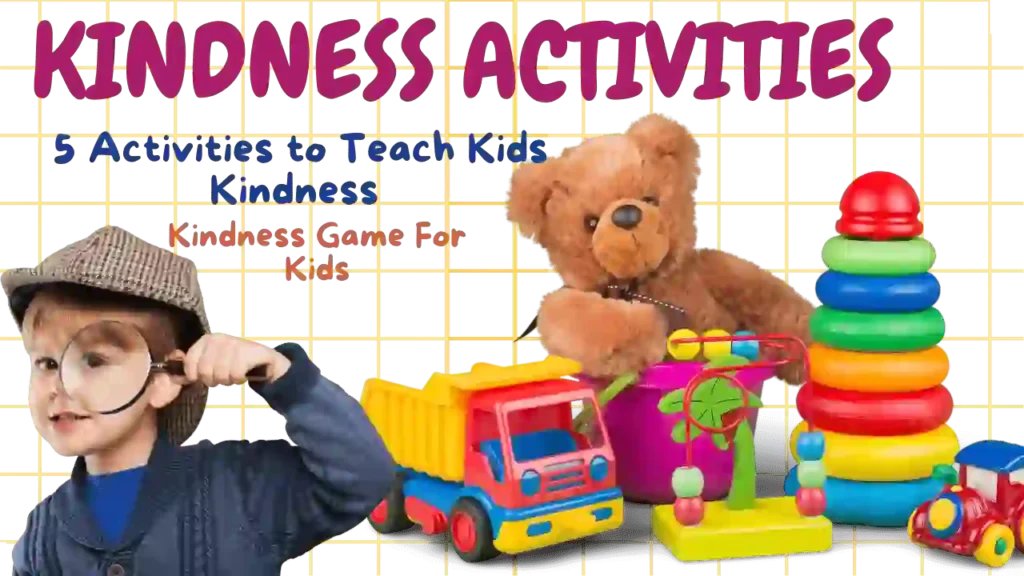As parents and educators, we want our kids to grow up to be kind and empathetic individuals. Teaching kindness is a vital part of child development (Growing) and can be easily incorporated into daily routines through fun and interactive Kindness Activities for kids. These Kindness Activities for kids not only encourage kindness and empathy among children but also make learning enjoyable for them.

Table of Contents
ToggleStand Up If: A Fun Way to Teach Kindness in the Classroom
This activity is a great way to encourage active listening and get to know your students or children better. For example, have the children sit in a circle and choose a characteristic of another person, like hair color or a hobby they have. Then, go around the circle and have each child take turns sharing the characteristic they chose by saying, “Stand up if [Dear Kid Enter here characteristic].” Every child who fits that characteristic should stand up. This activity helps children learn more about their peers and encourages them to be more empathetic toward one another (else).
For example, Olivia can compliment Emma on her beautiful Black Hair, Charlotte can compliment Amelia on her good sense of humor, and Ava can compliment Sophia on her artistic skills. This activity helps children get to know each other better and encourages them to be more empathetic toward one another.
Teaching Kindness with The Kindness Jar
Each time an act of kindness is observed, a penny is added to a designated jar. These acts can be announced to the children, and the jar is filled with a penny to represent the kind act that was noticed.
For example, if Harper helped Evelyn to carry her books, you would add a Penny (Cent or Small Amount of Dollars) to the jar and explain to the class that this was a kind act. Once the jar is full, buy the class or group a small treat (party), such as ice cream or a new game for the classroom. This activity not only encourages children to encourage children to be kind but also teaches them to notice and appreciate acts of kindness in others.
The Science of Kindness: The Toothpaste Experiment
This activity is a great way to combine science with kindness lessons. Give each child a small tube of toothpaste, a paper plate, and a plastic spoon. Then, have them squeeze the entire tube of toothpaste out onto the plate. When they are done, explain to them that mean words are similar to toothpaste. Once you put them out into the world, you cannot take them back no matter how hard you try.
For example, you can explain to them that spreading rumors (Gossip) or bullying is like squeezing (Press) toothpaste out of a tube, it is hard to take back once it is out there. This activity helps children understand the importance of thinking before they speak and act.
Teaching Empathy through The Empathy Walk Activity
Kindness Activities for kids is designed to help children (Kids) understand and empathize with different perspectives. Have the children walk around the room while you read a series of scenarios, such as “You just found out you did not make the soccer(Football) team,” or “Your best friend is moving away.” As each scenario or case is read, the children should stop and think about how they would feel in that situation and try to put themselves in the other person’s shoes.
Let us suppose, when you read the scenario “You just found out you did not make the soccer team”, the children can imagine themselves in this situation and think about how they would feel if they were the one who did not make the team. This activity helps children understand and empathize with different perspectives, encouraging them to be more compassionate (Understanding) and kind towards others.
The Kindness Scavenger Hunt
This activity can be done in the classroom or in the community (Family Circles). Create a list of kind acts that children can look for and complete, such as “Hold the door open for someone,” or “Leave a kind note for a friend (or Relatives).” Children can work in teams or individually to find and complete as many acts on the list as possible within a set period of time.
For example, Olivia and Harper team up to look for the acts on the list and complete them together. This activity encourages children to be proactive (take charge) in their kindness and to think creatively about ways to show kindness.
What are 10 ways to show kindness?
Here are a few ideas for being kind:
- Compliment others
- Hold the door open for someone
- Pick up trash
- Offer to help someone with a task
- Share a smile
- Actively and sympathetically listen
- Offer words of affirmation
- Send someone a note of appreciation
- Be inclusive and invite someone new to join a group activity
- Thank those around you and express your gratitude Shukriya).
Recommend Article:-
Kindness Game: Teaching Students to Be Kind in the Classroom